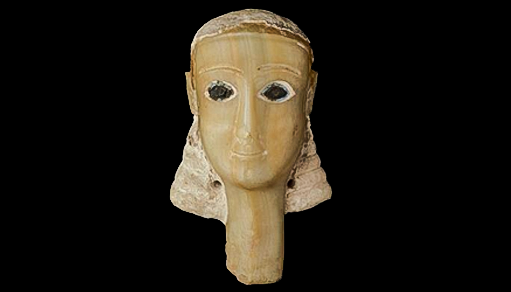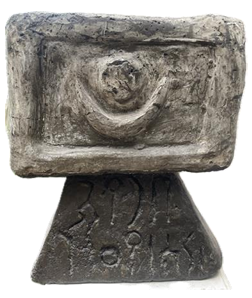(c)2021 Kinderen van Jemen – alle rechten voorbehouden aan de auteur | Websiteontwerp door Ingrid van de Linde – in samenwerking met Mediator Media
NEWS / BLOG
CHILDREN OF YEMEN
autumn 2025

The Mona Lisa of Arabia – Votive Head from Wadi Bayhan, 1st Century BC
Crafted from alabaster, stucco, and bitumen (13 x 18.2 x 17.3 cm), this serene female face with inlaid eyes exudes a timeless presence. It reflects the refined artistry and spiritual devotion of the pre-Islamic South Arabian civilisation.
In the Heart of Yemen: Then and Now
After the first steps of Children of Yemen website, there was almost two years of silence.
During that time, the war in Yemen intensified. The Houthis gained more control, violence spread, and daily life for millions became even more fragile. At the same time, in my personal life, there were circumstances that made it difficult to continue publishing. Yet the project never disappeared. It lived on quietly – in memory, in thought, in conversations, in the background of daily life.
With this essay, I return to the beginning. To the journey that once brought me to Yemen, and to the children I met there. A return not only in memory, but as a mirror to Yemen’s reality today.
This platform has become more of a visual museum than an active project. Yet the urgency remains – in Yemen, in Gaza, and in every place where children are forced to grow up in war.
A journey in 1999
When I travelled through Yemen in 1999, I entered a country that carried its history like a living poem.
Arabia Felix, the Happy Arabia, the land once sung by poets and chroniclers, revealed itself as a place of breathtaking originality.
In Sana’a, the old city rose like a vision: houses of earth and stone, their facades adorned with delicate white ornaments, windows glowing with coloured glass. At dusk the call to prayer wove through the air, and in the narrow streets children ran barefoot, their laughter echoing between the ancient walls.
I met their eyes. Bright, fearless, playful. Some of them stopped to pose proudly for my camera, others shyly turned away. In their gestures I saw the strength of a country that, though poor, was immensely rich in humanity.
In Shibam – the Manhattan of the desert – the clay skyscrapers touched the sky, a reminder that architecture can be both fragile and eternal. In the Hadramaut, women carried water with grace, their movements part of a rhythm older than memory. Figures like Queen Sheba and Queen Arwa haunted my imagination, not only as rulers of a distant past but as symbols of resilience and female wisdom.
Yemen was a land where poetry was not an ornament but a lifeline. In marketplaces, in schools, in families, words were recited, sung, embroidered into cloth. One ancient verse stayed with me:
If it is true,
That my origin is earth,
Then the whole world is my home,
And all the world my family.
For centuries, this text was woven into the caps of noble sons, until only eighty years ago. It became a thread in my own work, and in the Children of Yemen project that would be born years later.
The deep history: the Awam Temple and Sabaean women.
The ruins of the Awam Temple, witnesses to a glorious past, stand as symbols of the transience of even the mightiest empires.
Here, inscriptions were found that reveal an intriguing connection
between women and religious practices. Titles such as “Daughters of Ma’rib” or “Female Magicians” point to their roles as rainmakers and shamans.
The Sabaeans worshipped the sun and the moon, constructing temples in honour of these celestial bodies, believing they held sway over their lives, their harvests, and their destinies. They referred to themselves as “Children of Almaqah”. Inscriptions invoking him date from the seventh century BCE. The great temple of Ma’rib, often referred to as the Eighth Wonder of the World, is said to have been dedicated to him. Almaqah, a central deity in the ancient Arabian kingdom of Saba, was regarded as the god of the moon and the kingdom. His cult spread to neighbouring realms such as Dʿmt and Aksum (in present-day Ethiopia and Eritrea).
The Sabaeans saw themselves as part of a greater whole, striving for harmony with the cosmos. Their civilisation flourished for an astonishing fourteen centuries, until the fourth century CE.
There is also evidence of the sacred marriage rite in ancient Yemen, and of two women who served as religious specialists in the temple of the Sun God. They were responsible for interpreting dreams and maintaining temple records. The sacred marriage symbolised the bond between the earthly and the divine—the king and queen representing the god Almaqah (the moon god) and his consort. This union also served to strengthen the cohesion of the kingdom.
Einstein and the mystical cosmos
I perceive the divine as a gathering of cosmic forces. Or, as Einstein so aptly expressed it:
“The most beautiful and profound emotion we can experience is the sensation of the mystical. It is the source of all true science.”
Moreover, knowledge tells me: be gentle with destiny. Do not play with it. Nature is the greatest force—ultimately—and we are ‘slaves’ to nature and the cosmos. All the planets lie in symphony, with the furthest planet as the highest note. It holds the deepest forces.
Here I find resonance with Sabaean philosophy. My reference to Einstein’s view of the cosmos and belief in a divine order aligns with the Sabaean cosmology. In Sabaean art, we find countless references to the starry heavens, often depicted in conjunction with deities and mythological figures. The sphinxes, with their human heads and lion bodies, symbolised the connection between the earthly and the cosmic realms.
Einstein’s vision of the mystical and the cosmos touches the very heart of the human experience.
Just as the stars move in a fixed harmony, so too does humanity seek a balance between chaos and order. In Yemen, where the land is parched and the people hunger for peace, I feel the echo of this cosmic harmony.
The women I met—like the Queen of Sheba in her time—are now the bearers of this ancient force, fighting against the desiccation of both their land and their souls.
Echoes in the present
And yet, Yemen today is not only a place of ruins and memories. There are stories of artists, writers, and activists who, despite the war, continue to raise their voices. They wield their creativity as a weapon—to make the world aware of Yemen’s plight and to offer hope to future generations. It is a struggle for survival, but also a fight for identity and culture.
The war has brought famine and displacement:
• More than 18 million people are in urgent need of aid.
• Over 17 million face food insecurity, and more than 1 million children under 5 suffer from acute malnutrition.
• Families in refugee camps survive on bread, tea, and sometimes nothing more.
• Airstrikes and blockades continue to destroy hospitals, schools, and ports.
And yet, children still go to school, even in bombed-out buildings. Mothers still tell stories, even when food is scarce. Journalists like Fatehi Bin Lazreq in Aden risk their lives to expose corruption and defend dignity. These acts, small and immense at the same time, remind us that resilience is as old as the ruins of Ma’rib.
A visual museum of memory and urgency
This website, Children of Yemen, has become less of an active project and more of a platform – a visual museum of memory. It is not about daily updates, but about holding on to what must not be forgotten.
The children I photographed in 1999, the verses of Yemen’s poets, the echoes of Sheba and Arwa, the ruins of temples dedicated to sun and moon – they belong to a continuum of resilience. Today, Children in Gaza and in so many other conflict zones, mirror the fate of Yemen’s young: growing up in war, yet still drawing, still writing, still dreaming.
Closing
The ruins of the Awam Temple tell us that even empires fall, but symbols remain. The moon god Almaqah, the sacred marriage, the daughters of Ma’rib—all speak of a civilisation that sought balance between heaven and earth.
Today, in Yemen, women, artists and children carry that ancient force forward. They resist hunger with hope, they resist silence with poetry, they resist destruction with memory. Just as the stars move in harmony, so too does humanity continue to seek a balance between chaos and order
.
This platform, Children of Yemen, is a museum of that memory—reminding us that the urgency remains, not only here but also in Gaza and in every place where children grow up in war.
The children I met in 1999, the children of today, all belong to the same cosmic family.

Echoes of Ancient Devotion: A Reconstructed Incense Altar (2002) Inspired by the celestial reverence of pre Islamic South Arabia, this sculpture—crafted from aluminium cement with solar and lunar symbols (38 x 31 cm)—offers a tangible link to a time when sun and moon governed life and meaning. A contemporary expression of enduring ancient wisdom.